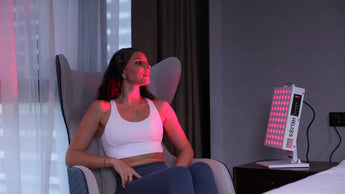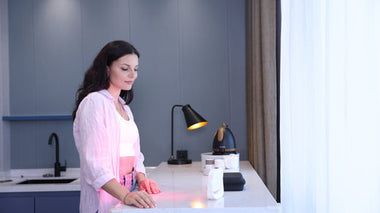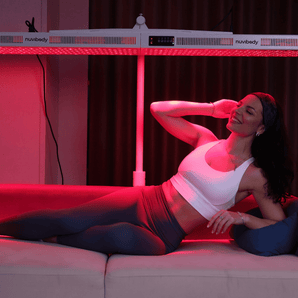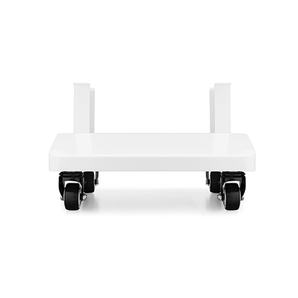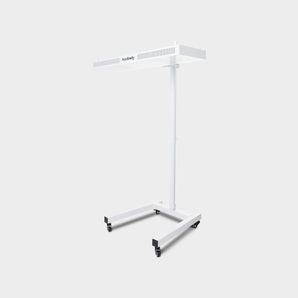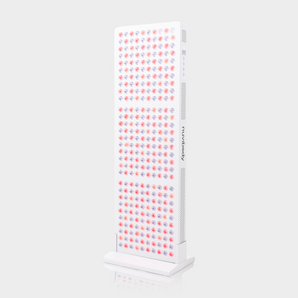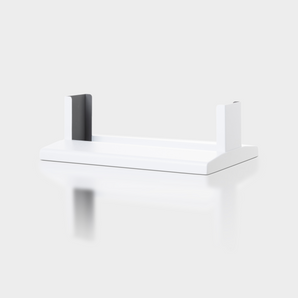It is common knowledge that red light therapy is beneficial for skin improvement, but today we are talking about a more serious topic: psoriasis.
Psoriasis can be quite annoying, causing itching and disrupting your daily life. Some psoriasis treatment tips are easier said than done. If you are curious about how red light therapy can help your psoriasis, you have come to the right place. We will answer all your questions in this article.
There are numerous therapies and miracle cures available on the internet that offer some hope to those suffering from psoriasis. The frequency of psoriasis flare-ups and their impact on your life depends on the severity of the condition. Fortunately, red light therapy is becoming more widely recognized as a treatment for conditions such as psoriasis. This often misunderstood skin condition is unpredictable, but it doesn’t have to disrupt your life or your self-confidence as long as you get your flare-ups under control.
Symptoms and Causes
This chronic autoimmune disease causes redness, itching and flaking of the skin. It is an incurable condition that can occur anywhere on the body, but most commonly on the inside of the elbows, knees and scalp. If you suffer from psoriasis, you know how annoying, itchy and sometimes life-disrupting this condition can be.
Psoriasis is thought to be caused by a problem with the immune system, which causes the skin to renew itself more quickly than normal. However, it is not yet fully understood what exactly disrupts the immune system. Researchers believe that both genetic and environmental factors play a role.
Common signs and symptoms include:
- Red patches on the skin covered with thick, silvery scales
- Small flaky spots (especially in children)
- Dry, cracked skin that may bleed or itch
- Itching, burning or pain
- Thickened, pitted or ridged nails
- Swollen and stiff joints
Different types of psoriasis are:
- Plaque psoriasis
- Nail psoriasis
- Guttate psoriasis
- Inverse psoriasis
- Pustular psoriasis
- Erythrodermic psoriasis
- Psoriatic arthritis
Treatment options for psoriasis include:
- Ointments and creams that are applied directly to the psoriasis spots
- Systemic and biological medications
- Red Light Therapy as support in the treatment of psoriasis
Remember that what works for one person will not necessarily work for another. Always consult a healthcare professional before incorporating new treatment methods, such as red light therapy, into your daily routine. What works in one context does not necessarily work for everyone.
Red light therapy and psoriasis
While there has been a fair amount of research into the benefits of red light therapy for the skin, research on psoriasis is still developing. However, many findings suggest that the skin improvement can be attributed to the anti-inflammatory effects of red light therapy. In short, red and near-infrared light stimulates the mitochondria of cells to produce ATP, the source of energy for every cell in the body. This form of therapy has a wide range of benefits, including reducing the intensity of flare-ups associated with psoriasis.
Experience with red light therapy against Psoriasis 
What does the research say?
In a 2011 study titled “ Effectiveness of Blue Light Versus Red Light in the Treatment of Psoriasis: A Double-Blind, Randomized Comparative Study, ” red light therapy was confirmed to be effective in treating psoriasis. In this particular study, the effectiveness of red light therapy and blue light therapy were measured in participants with psoriasis. Participants were given high-dose treatments three times per week for four weeks, while plaques were treated with a 10% salicylic acid solution. A significant improvement was observed in the relief of psoriasis symptoms after using the light therapy. It is important to note that these treatments were given in a medical setting and at high doses. Results may vary when used at home.
A 2010 study looked at the correlation between patients with chronic psoriasis and the use of a combination of 830-nm and 633-nm LED phototherapy (also known as red light therapy). According to this study, psoriasis symptoms improved significantly when patients were treated for 4-5 weeks with follow-up appointments. Additionally, red light therapy significantly reduced skin inflammation in psoriasis patients in this study. This reduction in inflammation relieves itching and discomfort and aids in the healing process.
The Relationship Between Skin Health and Red Light Therapy
The skin is the most naturally exposed organ to light, and research shows that it responds particularly well to red and near-infrared light under optimal conditions for therapeutic purposes. Red and near-infrared light stimulate dozens of biochemical processes within the cell and between cells in our bodies. Most scientists agree that the key underlying mechanism is how it stimulates energy production in the mitochondria. A cell with more energy can perform more of its natural functions, such as self-regeneration.
According to this article, inflammatory conditions such as psoriasis can benefit from low-level laser therapy, also known as red light therapy. The article states: "Light therapy has beneficial effects on wrinkles, acne scars, hypertrophic scars, and burn healing. Light therapy can reduce UV damage, both as a treatment and as a preventative measure. In pigmentary disorders such as vitiligo, light therapy can increase pigmentation by stimulating melanocyte proliferation and reduce depigmentation by inhibiting autoimmunity" (Avci P, Gupta A, Sadasivam M, et al., 2013). This is a promising statement for skin conditions.
Five reasons to choose red light therapy for psoriasis, according to scientific research:
- Achieve improved skin clearance. Improvements in skin tone and texture were commonly reported in many studies on red light therapy.
- Red light therapy can break the vicious cycle of excessive skin growth, which is one of the underlying factors of psoriasis. Red light therapy can help restore normal cell function, which can lead to fewer and milder flare-ups.
- Red light therapy can have a protective effect on the heart and joints. Psoriasis is more than just itchy skin. The chronic inflammatory process can cause damage to the cardiovascular system.
- You can easily add red light therapy to your routine in the comfort of your own home.
Experts claim that the best biological response comes from two wavelengths of red light: 660 nanometers and 850 nanometers. When learning about red light therapy, it’s important to understand wavelengths and the differences between red light and near-infrared (NIR) light. A Nuvibody light therapy lamp is always balanced, with half of the LEDs at 660 nm and the other half at 850 nm. Wavelengths at 660 nanometers are more easily absorbed by the skin’s surface, making them the preferred wavelength for superficial areas. Wavelengths at 850 nanometers penetrate deeper into the body, aiding in deeper skin layers, muscle recovery, and overall well-being.
Conclusion
We wish you the best in managing symptoms associated with psoriasis and overcoming psoriasis with a consistent wellness routine that may include red light therapy. By combining a healthy, balanced lifestyle with available treatments, you can make managing this condition easier.
By harnessing the power of red and infrared light, we may be able to reduce inflammation, relieve itching and promote skin healing in the comfort of our own home. The ease of use and non-invasive nature of this therapy make it a compelling choice for those looking for an alternative or complementary approach to traditional psoriasis therapies.
The Nuvibody red light therapy lamps are designed to provide you with the most powerful treatment to maximize your results. Discover the Nuvibody red light therapy collection here .
Sources:
- Ablon G. Combination 830-nm and 633-nm light-emitting diode phototherapy shows promise in the treatment of recalcitrant psoriasis: preliminary findings. Photomed Laser Surg. 2010 Feb;28(1):141-6. doi:10.1089/pho.2009.2484. PMID: 19764893.
- Avci P, Gupta A, Sadasivam M, et al. Low-level laser (light) therapy (LLLT) in skin: stimulating, healing, restoring. Semin Cutan Med Surg. 2013;32(1):41-52.
- Feldman SR, Goffe B, Rice G, et al. The Challenge of Managing Psoriasis: Unmet Medical Needs and Stakeholder Perspectives. Am Health Drug Benefits. 2016;9(9):504-513.
- Ferraresi C, Hamblin MR, Parizotto NA. Low-level laser (light) therapy (LLLT) on muscle tissue: performance, fatigue and repair benefited by the power of light. Photonics Lasers Med. 2012;1(4):267-286. doi:10.1515/plm-2012-0032
- Jiang M, Yan F, Avram M, Lu Z. A prospective study of the safety and efficacy of a combined bipolar radiofrequency, intense pulsed light, and infrared diode laser treatment for global facial photoaging. Lasers Med Sci. 2017 Jul;32(5):1051-1061. doi:10.1007/s10103-017-2207-9. Epub 2017 Apr 23. PMID: 28434049.
- Kleinpenning MM, Otero ME, van Erp PE, Gerritsen MJ, van de Kerkhof PC. Efficacy of blue light vs. red light in the treatment of psoriasis: a double-blind, randomized comparative study. J Eur Acad Dermatol Venereol. 2012 Feb;26(2):219-25. doi: 10.1111/j.1468-3083.2011.04039.x. Epub 2011 Mar 24. PMID: 21435024.
- Zhang P, Wu MX. A clinical review of phototherapy for psoriasis. Lasers Med Sci. 2018;33(1):173-180. doi:10.1007/s10103-017-2360-1


